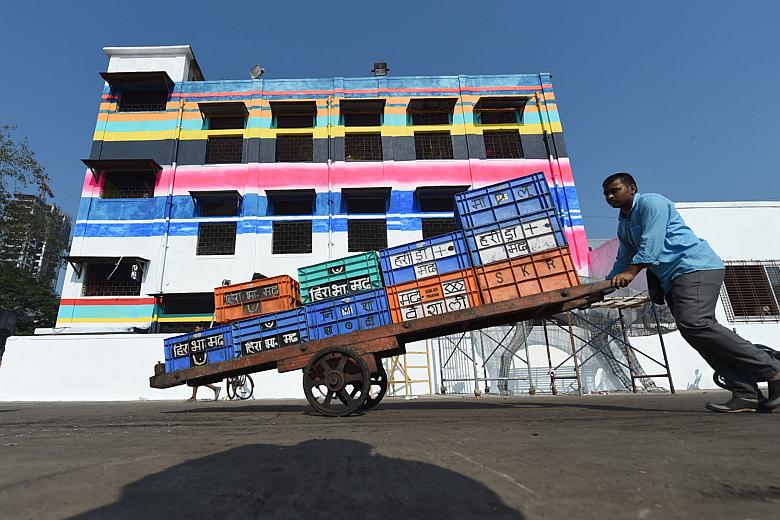Mumbai to redevelop its docklands: 5 cities that turned old docks into vibrant waterfronts
Sign up now: Get insights on Asia's fast-moving developments

A man pushing his cart load of fresh fish past the main venue of the St+art Festival at Sassoon Dock, one of the oldest fishing docks in Mumbai.
PHOTO: AFP
Follow topic:
MUMBAI (Thomson Reuters Foundation) - Mumbai is about to unveil an ambitious plan to redevelop its docklands, sprawled across 752 ha along a 14-km stretch of waterfront.
The proposed redevelopment is the biggest opening up of land in the city since the since the redevelopment of about 600 acres of textile-mill lands in the heart of Mumbai in the 1990s.
Here is a look at the revival of docks in five other cities that could serve as a model for Mumbai.
Barcelona
The Spanish city used the 1992 Summer Olympics to redevelop its waterfront, demolishing old warehouses and industrial buildings and creating 3 km of beachfront and a modern marina. New housing blocks were built, public spaces were refurbished and the area began to attract students, artists and lately, migrants.
London
When the Thames shipping business moved downstream to Tilbury, more than 2,000 ha of port facilities were left derelict.
The London Docklands Development Corporation was set up to ensure long-term social and economic regeneration. The "Docklands" is now made up of offices, shops, housing, leisure facilities and transport links, despite criticism that the regeneration favoured businesses.
San Francisco
The city has served as a port since its founding in 1863. A long-term project to redevelop the port was launched in 1997, and is still a work in progress, with the active participation of residents and businesses.
The 12-km stretch incorporates a continuously walkable waterfront, ample public spaces, retail spaces and adaptations to climate change.
Singapore
Port activities began at the Singapore River in the early years of the city's founding by Sir Stamford Raffles in 1819.
During the 1970s, as port activities were moved out, the government decided to retain the old façade along the river, ensuring the shop houses and godowns along Boat Quay and Clarke Quay were not only preserved, but enhanced, leading to a vibrant residential, commercial and civic district. The city similarly redeveloped old port land in the southern waterfront area.
Sydney
From the 1800s, Darling Harbour was the working port for Sydney, home to shipyards, factories, warehouses and crowded slums.
After the last goods train departed Darling Harbour in 1984, a plan was hatched to redevelop the former rail yards and wharves into recreational and commercial facilities. Four years later, the area was opened up to the public as an as entertainment and shopping precinct.
Sources: www.portdebarcelona.cat; portcities.org.uk; urban-hub.com; Singapore Ministry of National Development; gallery.records.nsw.gov.au

